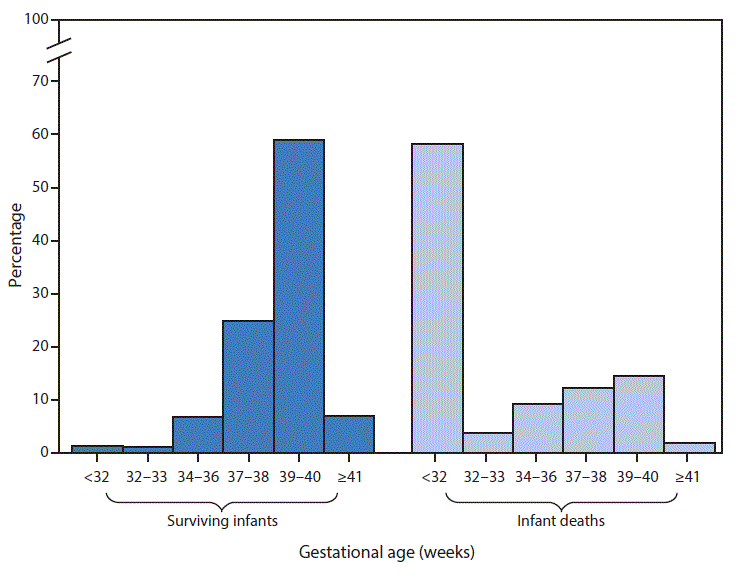QuickStats: Percentage Distribution of Gestational Age in Weeks for Infants Who Survived to Age 1 Year and Infants Who Died Before Age 1 Year — National Vital Statistics System, United States, 2014
Weekly / April 14, 2017 / 66(14);392
Please note: An erratum has been published for this report. To view the erratum, please click here.

Infants who do not survive the first year of life are more likely to be born at earlier gestational ages. In 2014, 66% of infants who survived to age 1 year were delivered at full term or later (≥39 completed weeks) compared with 16% of infants who died before reaching age 1 year. Fifty-eight percent of infants who died before age 1 year were delivered at <32 weeks gestation compared with only 1% of infants who survived to age 1 year.
Source: National Vital Statistics System, Linked Birth and Infant Death Data. https://www.cdc.gov/nchs/nvss/linked-birth.htm.
Reported by: Anne K. Driscoll, PhD, adriscoll1@cdc.gov, 301-458-4341.
Suggested citation for this article: QuickStats: Percentage Distribution of Gestational Age in Weeks for Infants Who Survived to Age 1 Year and Infants Who Died Before Age 1 Year — National Vital Statistics System, United States, 2014. MMWR Morb Mortal Wkly Rep 2017;66:392. DOI: http://dx.doi.org/10.15585/mmwr.mm6614a5.
Use of trade names and commercial sources is for identification only and does not imply endorsement by the U.S. Department of
Health and Human Services.
References to non-CDC sites on the Internet are
provided as a service to MMWR readers and do not constitute or imply
endorsement of these organizations or their programs by CDC or the U.S.
Department of Health and Human Services. CDC is not responsible for the content
of pages found at these sites. URL addresses listed in MMWR were current as of
the date of publication.
All HTML versions of MMWR articles are generated from final proofs through an automated process. This conversion might result in character translation or format errors in the HTML version. Users are referred to the electronic PDF version (https://www.cdc.gov/mmwr) and/or the original MMWR paper copy for printable versions of official text, figures, and tables.
Questions or messages regarding errors in formatting should be addressed to mmwrq@cdc.gov.
- Page last reviewed: August 1, 2017
- Page last updated: August 1, 2017
- Content source:


 ShareCompartir
ShareCompartir